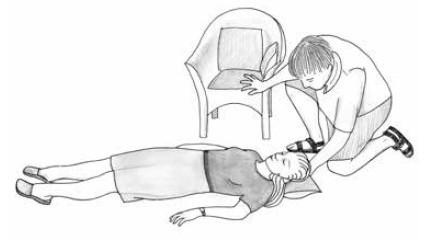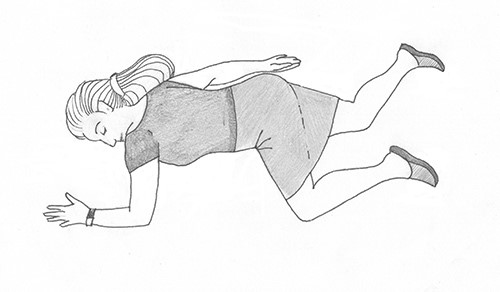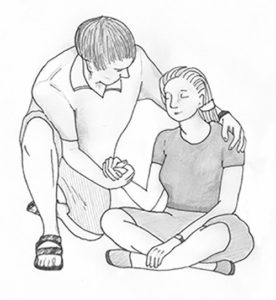It is not uncommon to feel frightened and helpless when witnessing someone have a seizure.
However, by learning to recognise the physical signs of seizures and knowing the appropriate first aid procedures, you can remain calm and help them both during and after their seizure.
How you should respond depends upon the type of epilepsy seizure the person is having. The most common seizure types are described below along with the recommended first aid response.
First Aid for Tonic-Clonic Seizures
Previously called grand mal seizures
During a tonic-clonic seizure, a person’s body stiffens and they fall to the ground (the tonic phase). Their limbs then begin to jerk in strong, symmetrical, rhythmic movements (the clonic phase).

The person may dribble from the mouth, go blue or red in the face, and occasionally lose control of their bladder and/or bowel.
Although this type of seizure can be frightening to watch, the seizure itself is unlikely to seriously harm the person having the seizure. They may however vomit or bite their tongue and can sometimes injure themselves if they hit nearby objects as they fall or convulse. The seizure generally stops after a few minutes. At this time the person is usually confused and drowsy. They may have a headache and want to sleep and this drowsiness can last for a number of hours.
In the event of a seizure follow instructions in the individual's seizure care plan.
If you do not know the person or there is no care plan:

DO
- stay calm - remain with the person.
- time the seizure.
- protect from injury - remove any hard objects from the area.
- protect the head - place something soft under their head and loosen any tight clothing.
- gently roll the person on their side as soon as it is possible to do so and firmly push the angle of the jaw forward to assist with breathing and allow any vomit to drain from their mouth without being inhaled.
- stay with the person until the seizure ends naturally and calmly talk to the person until the regain consciousness, usually within a few minutes.
- reassure the person that they are safe and that you will stay with them while they recover

Call an ambulance - 000 - if:
- the seizure activity lasts 5 or more minutes or a second seizure quickly follows
- the person remains non-responsive for more than 5 minutes after the seizure stops
- the person is having a greater number of seizures than is usual for them
- the person is injured, goes blue in the face or has swallowed water
- the person is pregnant
- you know, or believe it to be, the person's first seizure
- you feel uncomfortable dealing with the seizure at the time
NOTE
Prolonged, continuous, or repetitive tonic-clonic seizures require urgent medical attention.
DO NOT
- restrain the person's movements
- force anything into the mouth
- give the person water, pills or food until they are fully alert
First Aid for Focal Seizures
Previously called partial seizures
During a focal seizure, the person may appear unresponsive and confused. Automatic movements such as smacking of the lips, wandering, or fumbling movements of the hand may be present. He or she may display inappropriate behaviour that may be mistaken for alcohol/drug intoxication or psychiatric disturbance.
In the event of a focal seizure follow instructions in the individual's seizure care plan.
If you do not know the person or there is no care plan:
DO
- gently guide the person past obstacles and away from dangerous places.
- calmly talk with the person as they regain awareness and ask if they are OK.
- reassure the person that they are safe and that you will stay with them while they recover.
- time how long the seizure lasts.
Call an ambulance - 000 - if:
- the seizure activity lasts 5 or more minutes or a second seizure quickly follows.
- the person remains non-responsive for more than 5 minutes after the seizure stops.
- the person is having a greater number of seizures than is usual for them.
- the person is injured, goes blue in the face or has swallowed water.
- the person is pregnant.
- you know or believe this to be the person's first seizure.
- you feel uncomfortable dealing with the seizure at the time.
First Aid for Absence Seizures
Previously called petit mal seizures
An absence seizure causes loss of awareness for a brief period. The person stares vacantly, the eyes may drift upwards and flicker. It may be mistaken for daydreaming.
DO
- recognize that a seizure has occurred.
- reassure the person.
- repeat any information that may have been missed during the seizure.
First Aid for Other Situations
First Aid for a Seizure In Water
In certain situations, a loss of consciousness is especially dangerous and emergency care must go beyond the routine procedures. A seizure in water is a life-threatening situation.
DO
- support the person in the water with the head tilted so the face and head stay above the surface.
- remove the person from the water as soon as the active movements of the seizure have ceased.
- check to see whether the person is breathing and whether they have a pulse. If they are not breathing but have a pulse start mouth to mouth resuscitation and immediately call 000. The operator will instruct you step by step while an ambulance is despatched.
- even if the person appears to be fully recovered, call an ambulance. The person should have a full medical check as inhaling water can cause lung or heart damage.
DO NOT
- Let the person continue with swimming or water sports that day, even if they appear to be fully recovered

First Aid for a Seizure in a Wheel Chair
If someone starts to have a seizure while confined in a wheelchair, seated on a bus, train or tram or strapped in a pram or stroller:
DO
- protect the person by preventing them from falling if there is no seat belt
- make sure the wheelchair or the stroller is secure
- protect the person by supporting their head
- check whether you need to move any hard objects that might hurt arms and legs in particular
- time how long the seizure lasts
- wait to ensure consciousness returns within a few minutes
- reassure the person and tell them what has happened
NOTE:
When the seizure has finished you need to ensure their airway is clear. This may involve removing food or vomit from their mouth and supporting their head to maintain a clear airway. It may or may not be appropriate to remove the person from the chair at the end of the seizure.
This will depend on your assessment of the safety issues involved both for you and them.
Call an ambulance - 000 - if:
- the seizure activity lasts 5 or more minutes or a second seizure quickly follows
- the person is not conscious within 5 minutes of the seizure stopping
- the person is injured
- the person is pregnant or has diabetes
- you know, or believe it to be the person’s first seizure
- you know, or believe it to be the person’s first seizure
- you are in doubt
DO NOT
- try to stop the seizure
- put anything in the person’s mouth
- try to remove them from their wheelchair – in most cases, the seat provides some support
